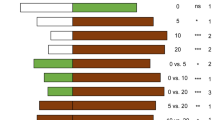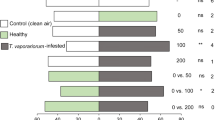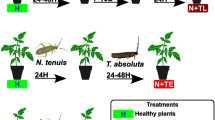Abstract
Herbivore-induced plant volatiles (HIPVs) and host sex pheromones are important semiochemicals used by natural enemies to locate prey or hosts. The egg parasitoid Trichogramma achaeae Nagaraja & Nagarkatti has recently shown potential for use as a biological control agent of Tuta absoluta (Meyrick), a key pest of tomato crops worldwide. In this study, we used olfactometer tests to examine the behavioral response of T. achaeae females to T. absoluta sex pheromone or to HIPVs produced by tomato plants infested with T. absoluta eggs or larvae. Our results showed that T. achaeae was attracted to T. absoluta sex pheromone. Parasitoids were also innately attracted to volatiles produced by tomato plants, whether uninfested or infested. However, parasitoids could not distinguish between volatiles from uninfested or T. absoluta-infested tomato plants. We characterized the headspace volatiles of tomato plants used in the olfactometer tests and found out that oviposition and larval feeding by T. absoluta significantly enhanced HIPV emission. This study suggests that the sex pheromone of T. absoluta is a potential tool to manipulate the behavior of T. achaeae and improve its attraction to the tomato crop. The analysis of volatiles released by tomato plants, either infested or uninfested, coupled with the response of T. achaeae in the olfactometer tests was consistent with what was expected in terms of the foraging behavior of a generalist parasitoid. The results and implications are further discussed in the context of sustainable T. absoluta management.


Similar content being viewed by others
References
Ahamdi S, Poorjavad M (2018) Behavioral and biological effects of exposure to Tuta absoluta (lepidoptera: gelechiidae) sex pheromone on several Trichogramma (hymenoptera: trichogrammatidae) populations. J Econ Entomol. https://doi.org/10.1093/jee/toy212 (in press)
Alsaedi G, Ashouri A, Talaei-Hassanloui R (2016) Behavioral responses of the three Trichogramma species to different odor sources. J Entomol Zool Stud 4(4):1924
Anastasaki E, Drizou F, Milonas PG (2018) Electrophysiological and oviposition responses of Tuta absoluta females to herbivore-induced volatiles in tomato plants. J Chem Ecol. https://doi.org/10.1007/s10886-018-0929-1
Arakaki N, Wakamura S, Yasuda T (1996) Phoretic egg parasitoid, Telenomus euproctidis (Hymenoptera: Scelionidae), uses sex pheromone of tussock moth Euproctis taiwana (Lepidoptera: Lymantriidae) as a kairomone. J Chem Ecol 22:1079–1085
Backer LD, Megido RC, Fouconnier ML, Brostaux Y, Francis F, Verheggen F (2015) Tuta absoluta-induced plant volatiles: attractiveness towards the generalist predator Macrolophus pygmaeus. Arthropod-Plant Interact 9:465–476. https://doi.org/10.1007/s11829-015-9388-6
Biondi A, Guedes RNC, Wan FH, Desneux N (2018) Ecology, worldwide spread, and management of the invasive south american tomato pinworm, Tuta absoluta: past, present, and future. Annu Rev Entomol 63:239–258
Cabello T, Gallego JR, Vila E, Soler A, del Pino M, Carnero A et al (2009) Biological control of the South American tomato pinworm, Tuta absoluta (Lepidoptera: Gelechiidae), with releases of Trichogramma achaeae (Hym.: Trichogrammatidae) in tomato greenhouses of Spain. IOBC/WPRS Bull 49:225–230
Cabello T, Gallego JR, Fernandez FJ, Gamez M, Vila E, del Pino M, Hernandez-Suarez E (2012) Biological control strategies for the South American tomato moth (Lepidoptera: Gelechiidae) in greenhouse tomatoes. J Econ Entomol 105(6):2085–2096
Cagnotti CL, Hernández CM, Andormo AV, Viscarret M, Riquelme M, Botto EN, López SN (2016) Acceptability and suitability of Tuta absoluta eggs from irradiated parents to parasitism by Trichogramma nerudai and Trichogramma pretiosum (Hymenoptera: Trichogrammatidae). Agric For Entomol 18:198–205
Campos MR, Biondi A, Adiga A, Guedes RNC, Desneux N (2017) From the Western Palaearctic region to beyond: Tuta absoluta 10 years after invading Europe. J Pest Sci 90:787–796
Cascone P, Carpenito S, Slotsbo S, Iodice L, Sørensen GJ, Holmstrup M, Guerrieri E (2015) Improving the efficiency of Trichogramma achaeae to control Tuta absoluta. Biocontrol 60:761–771
Chailleux A, Desneux N, Seguret J, Do Thi Khanh H, Maignet P, Tabone E (2012) Assessing European egg parasitoids as a mean of controlling the invasive South American tomato pinworm Tuta absoluta. PLoS ONE 7:e48068
Chailleux A, Biondi A, Han P, Tabone E, Desneux N (2013) Suitability of the pest–plant system Tuta absoluta (Lepidoptera: Gelechiidae)—tomato for Trichogramma (Hymenoptera: Trichogrammatidae) parasitoids and insights for biological control. J Econ Entomol 106:2310–2321
Cherif A, Mansour R, Attia-Barhoumi S, Zappalà L, Grissa-Lebdi K (2018) Effectiveness of different release rates of Trichogramma cacoeciae (Hymenoptera: Trichogrammatidae) against Tuta absoluta (Lepidoptera: Gelechiidae) in protected and open field tomato crops in Tunisia. Biocontrol Sci Technol. https://doi.org/10.1080/09583157.2018.1542485
Cocco A, Deliperi S, Delrio G (2013) Control of Tuta absoluta (Meyrick) (Lepidoptera: Gelechiidae) in greenhouse tomato crops using the mating disruption technique. J Appl Entomol 137:16–28
Coppola M, Cascone P, Madonna V, Di Lelio I, Esposito F, Avitabile C, Romanelli A, Guerrieri E, Vitiello A, Pennacchio F, Rao R, Corrado G (2017) Plant-to-plant communication triggered by systemin primes anti-herbivore resistance in tomato. Sci Rep. https://doi.org/10.1038/s41598-017-15481-8
Degenhardt J, Kollner TG, Gershenzon J (2009) Monoterpene and sesquiterpene synthases and the origin of terpene skeletal diversity in plants. Phytochemistry 70:1621–1637
Degenhardt DC, Refi-Hind S, Stratmann JW, Lincoln DE (2010) Systemin and jasmonic acid regulate constitutive and herbivore-induced systemic volatile emissions in tomato, Solanum lycopersicum. Phytochemistry 71:2024–2037
Desneux N, Wajnberg E, Wyckhuys KAG et al (2010) Biological invasion of European tomato crops by Tuta absoluta: ecology, geographic expansion and prospects for biological control. J Pest Sci 83:197–215
Dicke M (1994) Local and systemic production of volatile herbivore-induced terpenoids: their role in plant-carnivore mutualism. J Plant Physiol 143:465–472
Dicke M, Baldwin IT (2010) The evolutionary context for herbivore-induced plant volatiles: beyond the ‘cry for help’. Trends Plant Sci 15:167–175
Dudareva N, Negre F, Nagegowda DA, Orlova I (2006) Plant volatiles: recent advances and future perspectives. Crit Rev Plant Sci 25:417–440
El-Arnaouty SA, Pizzol J, Galal HH, Kortam MN, Afifi AI et al (2014) Assessment of two Trichogramma species for the control of Tuta absoluta in North African tomato greenhouses. Afr Entomol 22:801–809
Farag MA, Paré PW (2002) C6 green leaf volatiles trigger local and systemic VOC emissions in tomato. Phytochemistry 61:545–554
Faria CA, Torres JB, Fernandes AMV, Farias AMI (2008) Parasitism of Tuta absoluta in tomato plants by Trichogramma pretiosum Riley in response to host density and plant structures. Cienc Rural 38:1504–1509
Fatouros NE, Lucas-Barbosa D, Weldegergis BT, Pashalidou FG, van Loon JJA et al (2012) Plant volatiles induced by herbivore egg deposition affect insects of different trophic levels. PLoS ONE 7(8):e43607. https://doi.org/10.1371/journal.pone.0043607
Giorgini M, Guerrieri E, Cascone P, Gontijo L (2019) Current strategies and future outlook for managing the Neotropical tomato pest Tuta absoluta (Meyrick) in the Mediterranean Basin. Neotrop Entomol. https://doi.org/10.1007/s13744-018-0636-1
Guedes RNC, Picanço MC (2012) The tomato borer Tuta absoluta in South America: pest status, management and insecticide resistance. EPPO Bull 42:211–216
Han P, Bayram Y, Shaltiel-Harpaz L, Sohrabi F, Saji A, Esenali UT, Jalilov A, Ali A, Shashank PR, Ismoilov K, Lu ZZ, Wang S, Zhang GF, Wan FH, Biondi A, Desneux N (2019) Tuta absoluta continues to disperse in Asia: damage, ongoing management and future challenges. J Pest Sci. https://doi.org/10.1007/s10340-018-1062-1
Hervé M (2017) RVAideMemoire: testing and plotting procedures for biostatistics. https://CRAN.R-project.org/package=RVAideMemoire. Accessed 2 Aug 2018
Hilker M, Meiners T (2011) Plants and insect eggs: how do they affect each other? Phytochemistry 72:1612–1623
Huigens ME, Woelk JB, Pashalidou FG, Bukovinszky T, Smid HM, Fatouros NE (2010) Chemical espionage on species-specific butterfly anti-aphrodisiacs by hitchhiking Trichogramma wasps. Behav Ecol 21:470–478
Kopke D, Schröder R, Fischer HM, Gershenzon G, Hilker M, Schmidt A (2008) Does egg deposition by herbivorous pine sawflies affect transcription of sesquiterpene synthases in pine? Planta 22:427–438
Kortam MN, El Arnaouty SA, Fatnassi H, Afifi AI, Pizzol J, Suloma A, Poncet C (2017) The effect of microclimatic parameters on two Trichogramma species used to control Tuta absoluta. IOBC-WPRS Bull 124(131):137
Lewis WJ, Nordlund DA, Gueldne RC, Teal PEA, Tumlinson JH (1982) Kairomones and their use for management of entomophagous insects: XIII. Kairomonal activity for Trichogramma spp. of abdominal tips, excretion, and a synthetic sex pheromone blend of Heliothis zea (Boddie) moths. J Chem Ecol 8:1323–1331
Lietti MMM, Botto E, Alzogaray RA (2005) Insecticide resistance in argentine populations of Tuta absoluta. Neotrop Entomol 34:113–119
López E (1991) Polilla del tomate: problema crítico para la rentabilidad del cultivo de verano. Empresa y Avance Agrícola 1:6–7
Mansour R, Brévault T, Chailleux A, Cherif A, Grissa-Lebdi K, Haddi K, Mohamed SA, Nofemela RS, Oke A, Sylla S, Tonnang HEZ, Zappalà L, Kenis M, Desneux N, Biondi A (2018) Occurrence, biology, natural enemies and management of Tuta absoluta in Africa. Entomol Gen 38(2):83–112
Mumm R, Dicke M (2010) Variation in natural plant products and the attraction of bodyguards for indirect plant defense. Can J Zool 88:628–667
Mumm R, Schrank K, Wegener R, Schulz S, Hilker M (2003) Chemical analysis of volatiles emitted by Pinus sylvestris after induction by insect oviposition. J Chem Ecol 29:1235–1252
Naselli M, Zappalà L, Gugliuzzo A, Tropea Garzia G, Biondi A, Rapisarda C, Cincotta F, Condurso C, Verzera A, Siscaro G (2017) Olfactory response of the zoophytophagous mirid Nesidiocoris tenuis to tomato and alternative host plants. Arthropod–Plant Interact 11:121–131
Noldus LPJJ, van Lenteren JC, Lewis WJ (1991) How Trichogramma parasitoids use moth sex pheromones as kairomones: orientation behaviour in a wind tunnel. Physiol Entomol 16:313–327
Nordlund DA, Chalfant RB, Lewis WJ (1985) Response of Trichogramma pretiosum females to volatile synomones from tomato plants. J Entomol Sci 20(3):372–376
Oliveira L, Durão AC, Fontes J, Roja IS, Tavares J (2017) Potential of Trichogramma achaeae (Hymenoptera: Trichogrammatidae) in biological control of Tuta absoluta (Lepidoptera: Gelechiidae) in Azorean greenhouse tomato crops. J Econ Entomol 110:2010–2015
Parra JRP, Zucchi RA (2004) Trichogramma in Brazil: feasibility of use after twenty years of research. Neotrop Entomol 33:271–281
Pashalidou FG, Huigens ME, Dicke M, Fatouros NE (2010) The use of oviposition-induced plant cues by Trichogramma egg parasitoids. Ecol Entomol 35:748–753
Perez-Hedo M, Suay R, Alonso M, Ruocco M, Giorgini M, Poncet C, Urbaneja A (2017) Resilience and robustness of IPM in protected horticulture in the face of potential invasive pests. Crop Prot 97:119–127
Picanço MC, Leite GLD, Guedes RNC, Silva EA (1998) Yield loss in trellised tomato affected by insecticidal sprays and plant spacing. Crop Prot 17:447–452
Polaszek A, Rugman-Jones PF, Stouthamer R, Hernandez-Suarez E, Cabello T (2012) Molecular and morphological diagnoses of five species of Trichogramma: biological control agents of Chrysodeixis chalcites (Lepidoptera: Noctuidae) and Tuta absoluta (Lepidoptera: Gelechiidae) in the Canary Islands. Biocontrol 57:21–36
Pratissoli D, Thuler RT, Andrade GS, Zanotti LCM, Silva AF (2005) Estimate of Trichogramma pretiosum to control Tuta absoluta in stalked tomato. Pesqui Agropecu Bras 40:715–718
Proffit M, Birgersson G, Bengtsson M, Reis R, Witzgall P, Lima E (2011) Attraction and oviposition of Tuta absoluta females in response to tomato leaf volatiles. J Chem Ecol 37:565–574
R Core Team (2018) R: a language and environment for statistical computing. R Foundation for Statistical Computing, Vienna, Austria. http://www.R-project.org/. Accessed 2 Aug 2018
Rani PU, Sandhyarani K (2012) Specificity of systemically released rice stem volatiles on egg parasitoid, Trichogramma japonicum Ashmead behavior. J Appl Entomol 136:749–760
Reddy GVP, Holopainen JK, Guerrero A (2002) Olfactory responses of Plutella xylostella natural enemies to host pheromone, larval frass, and green leaf cabbage volatiles. J Chem Ecol 28:131–143
Roditakis E, Vasakis E, García-Vidal L, Martínez-Aguirre MDR, Rison JL, Haxaire-Lutun MO, Nauen R, Tsagkarakou A, Bielza P (2018) A four-year survey on insecticide resistance and likelihood of chemical control failure for tomato leaf miner Tuta absoluta in the European/Asian region. J Pest Sci 91:421–435. https://doi.org/10.1007/s10340-017-0900-x
Rohart F, Gautier B, Singh A, Lê Cao K-A (2017) mixOmics: An R package for ‘omics feature selection and multiple data integration. PLoS Comput Biol 13(11):e1005752. https://doi.org/10.1371/journal.pcbi.1005752
Sacchettini JC, Poulter CD (1997) Biochemistry-creating isoprenoid diversity. Science 277:1788–1789
Silva GA, Picanço MC, Bacci L, Crespo ALB, Rosado JF, Guedes RNC (2011) Control failure likelihood and spatial dependence of insecticide resistance in the tomato pinworm, Tuta absoluta. Pest Manag Sci 67:913–920
Silva DB, Weldegergis BT, Van Loon JJA, Bueno VHP (2017) Qualitative and quantitative differences in herbivore-induced plant volatile blends from tomato plants infested by either Tuta absoluta or Bemisia tabaci. J Chem Ecol 43:53–65
Silva JE, Ribeiro LMS, Vinasco N, Guedes RNC, Siqueira HAA (2019) Field-evolved resistance to chlorantraniliprole in the tomato pinworm Tuta absoluta: inheritance, cross-resistance profile, and metabolism. J Pest Sci. https://doi.org/10.1007/s10340-018-1064-z
Siqueira HAA, Guedes RNC, Picanco MC (2000) Insecticide resistance in populations of Tuta absoluta (Lepidoptera:Gelechiidae). Agric For Entomol 2:147–153
Takabayashi J, Dicke M, Posthumus MA (1994) Volatile herbivore-induced terpenoids in plant-mite interactions: variation caused by biotic and abiotic factors. J Chem Ecol 20:1329–1354
Tropea Garzia G, Siscaro G, Biondi A, Zappalà L (2012) Tuta absoluta, a South American pest of tomato now in the EPPO region: biology, distribution and damage. EPPO Bull 42:205–210
Turlings TCJ, Wackers FI, Vet LEM, Lewis WJ, Tumlinson JH (1993) Learning of host-finding cues by hymenopterous parasitoids. In: Papaj DR, Lewis WJ (eds) Insect learning. Chapman and Hall, New York, pp 51–78
Unsicker SB, Kunert G, Gershenzon J (2009) Protective perfumes: the role of vegetative volatiles in plant defense against herbivores. Curr Opin Plant Biol 12:479–485
Urbaneja A, González-Cabrera J, Arnó J, Gabar R (2012) Prospects for the biological control of Tuta absoluta in tomatoes of the Mediterranean basin. Pest Manag Sci 68:1215–1222
van Lenteren JC, Bolckmans K, Köhl J, Ravensberg WJ, Urbaneja A (2018) Biological control using invertebrates and microorganisms: plenty of new opportunities. Biocontrol 63:39–59
Vet LEM, Dicke M (1992) Ecology of infochemical use by natural enemies in a tritrophic context. Ann Rev Entomol 37:141–172
Wilson JK, Woods HA (2016) Innate and learned olfactory responses in a wild population of the egg parasitoid Trichogramma (Hymenoptera: Trichogrammatidae). J Insect Sci 16(1):1–8
Wright MG, Stouthamer R (2011) First report of Trichogramma achaeae (Hymenoptera: Trichogrammatidae) from Hawaii. Proc Hawaii Entomol Soc 43:67
Zappalà L, Biondi A, Alma A, Al-Jboory IJ, Arnò J, Bayram A, Chailleux A, El-Arnaouty A, Gerling D, Guenaoui Y, Shaltiel-Harpaz L, Siscaro G, Stavrinides M, Tavella L, Aznar RV, Urbaneja A, Desneux N (2013) Natural enemies of the South American moth, Tuta absoluta, in Europe, North Africa and Middle East, and their potential use in pest control strategies. J Pest Sci 86(4):635–647
Acknowledgements
This work has been supported by the EU FP7 project ‘Ameliorating the Sustainable Control of Invasive Insects’ (PIRSES 318246). The work was also supported by ‘Fundação de Amparo a Pesquisa do Estado de Minas Gerais’—FAPEMIG (grant FORTIS-TCT-10254/2014). The authors would like to show their gratitude to Gabriele Cencetti (IBBR-CNR, ARCA Laboratory) for helping with GC–MS analyses.
Author information
Authors and Affiliations
Corresponding author
Additional information
Communicated by A. Biondi and N. Desneux.
Publisher's Note
Springer Nature remains neutral with regard to jurisdictional claims in published maps and institutional affiliations.
Rights and permissions
About this article
Cite this article
Gontijo, L., Cascone, P., Giorgini, M. et al. Relative importance of host and plant semiochemicals in the foraging behavior of Trichogramma achaeae, an egg parasitoid of Tuta absoluta. J Pest Sci 92, 1479–1488 (2019). https://doi.org/10.1007/s10340-019-01091-y
Received:
Revised:
Accepted:
Published:
Issue Date:
DOI: https://doi.org/10.1007/s10340-019-01091-y




